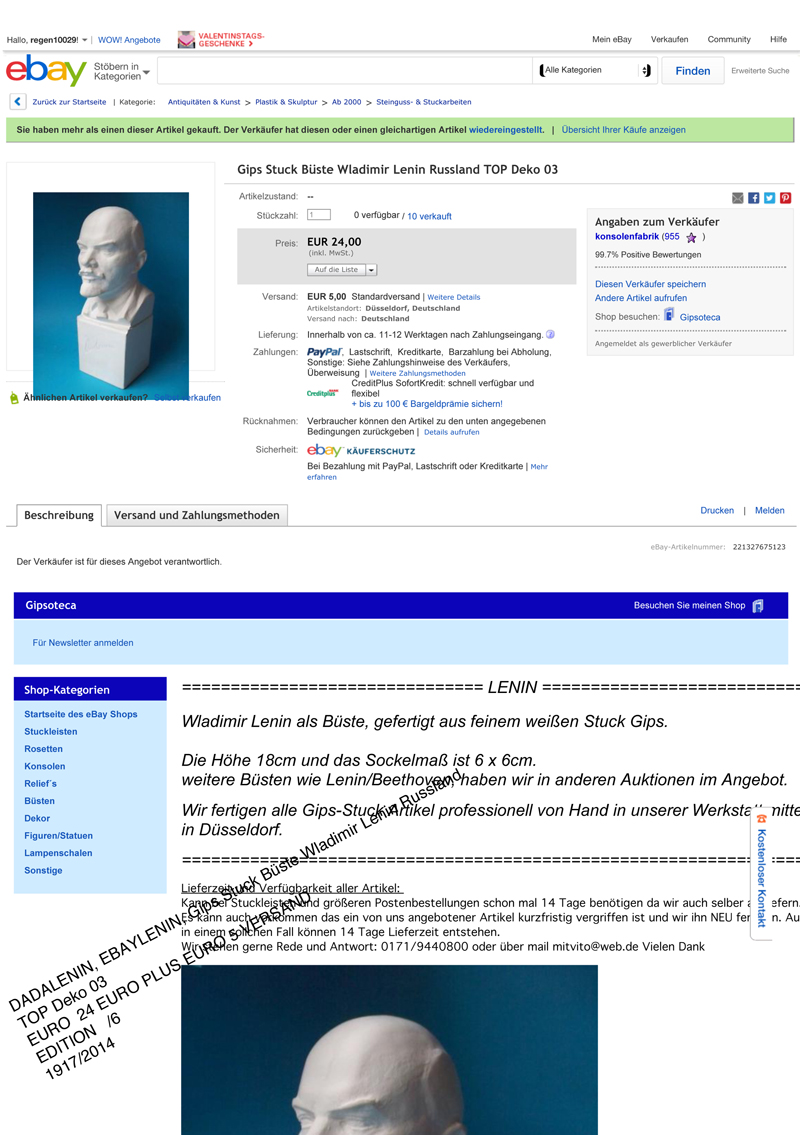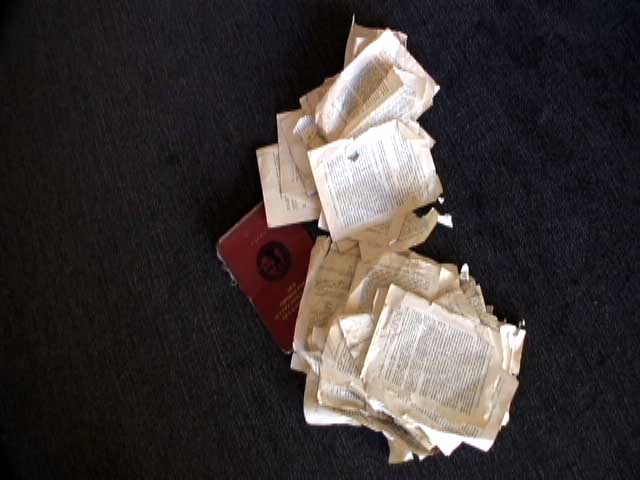website under construction
CABARET VOLTAIRE, Zurich.. 2014 (06.02. - 27.04.2014) #
ps: more about this work ...see here. dadalenin.com
the wall installatioon is a permaent made by the institution where Dada was founded about 100 years ago; the exhibition had to take place in the vitirines in the basement this historic place where DADA was founded by Hugo Ball and Emmy Hennings as well as others who joined.
work titles to come
DADALENIN originated in Bucharest in 2006 during one of my Reading Frantz Fanon series when Adrian Notz, a curator of the Cabaret Voltaire, invited me to Zürich. Once I was told that Lenin lived in the same small street, Spiegelgasse 14, precisely when DADA first came into being, I became thrilled to work on his famous book Imperialism, the highest stage of capitalism, written at that time. I also became more fascinated about the high probability of Lenin as a participant of the original Dada movement. The hilarious book on that subject by Dominique Noguez, Lenin dada, Limmat Verlag, 1990, as well as the easily available dairy by Hugo Ball, Flight Out of Time: A Dada Diary, University of California Press, 1996 inspired me. Only a few months later, I started holding Lenin readings with friends at home as well as for other occasions before I first made it to Zürich. Upon my arrival, I performed a Lenin book destruction resulting in a video and a destroyed book, opening up the space for more work on the DADALENIN. To more precise, the work turned into a sprawling enterprise growing from event to event, exhibition to exhibition that still today, seven years later still doesn’t let me completely go. I will not offer more details here since it is sufficiently described and documented throughout this publication.
Working through this material is revisiting a world of conflicts that was in the end never really digested. It also felt like the research of a journalist or of a historian going through cans of worms that are still alive. It also poses ethical questions since so many decisions made during times of war, hunger and indescribable misery cannot be so easily judged from today. In his conversation with me Boris Groys goes very far in trying to understand what drives people to think, accept and act in these unimaginable ways that characterize times of lethal conflicts and bloody radical change. Today, when we observe the brutal mayhem of war as it occurs for example in Syria while I am writing we explain it laterally, disassociating it through cultural, temporal or religious sets of pre-fabricated explanations. “They are living in the past, they are so different and backwards, or even worse – they are religious others etc… “ and we – a Western European/North American we - forget that the most murderous and viscous acts of war and war crimes in the XXth century were committed by the most advanced Europeans powers against each other mainly in pursuit of oversea colonies. I am not even talking about the Balkan wars of the 1990s, a few hours away from Vienna or Venice. I am also not talking about the direct and indirect influences the so-called West still has in the current world of lethal unresolved conflicts hinting to Iraq, Afghanistan, etc.. Looking from a perspective of war and agony at cultural production and art is necessary to understand Dada and even more so DADALENIN. War, destruction, utopian and crazy ideologies in concert with radical, forceful, immediate change is setting free forces that all are worth to be called DADALENIN. It’s like a walk on the wild side of history, a walk millions were forced to take without return – and still are. It’s tragic and produces comical distortions, it’s DADALENIN.
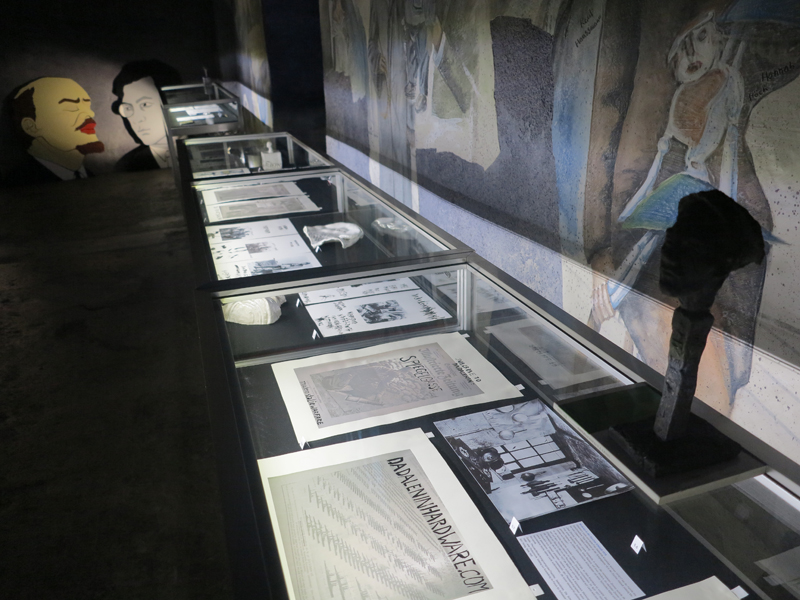
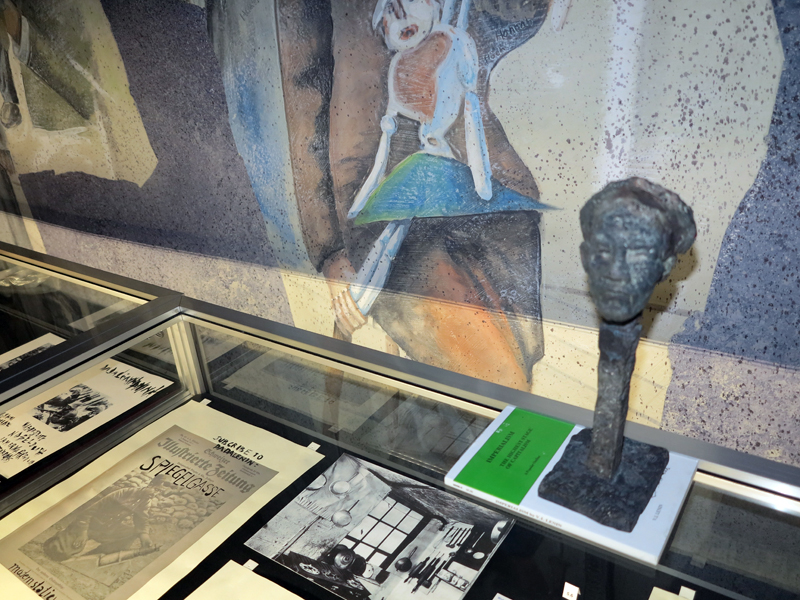

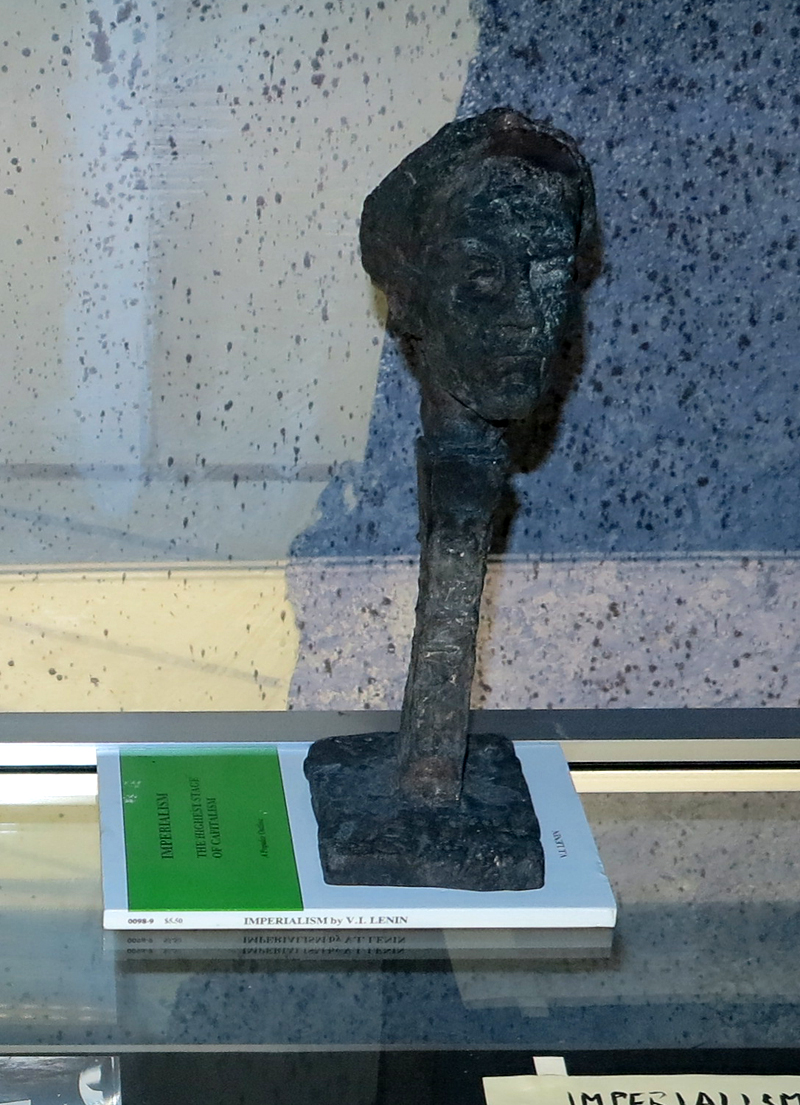
DADALENIN, Imperialism, the Highest Stage of Capitalism, bronze 29 x 9 x 11.5; paper book 1 x 21 x 14 cm

LENIN s kitchen
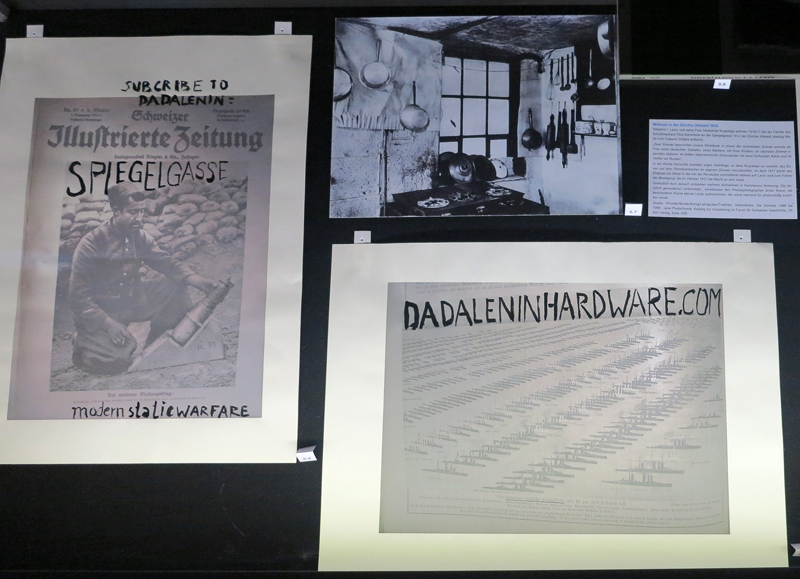
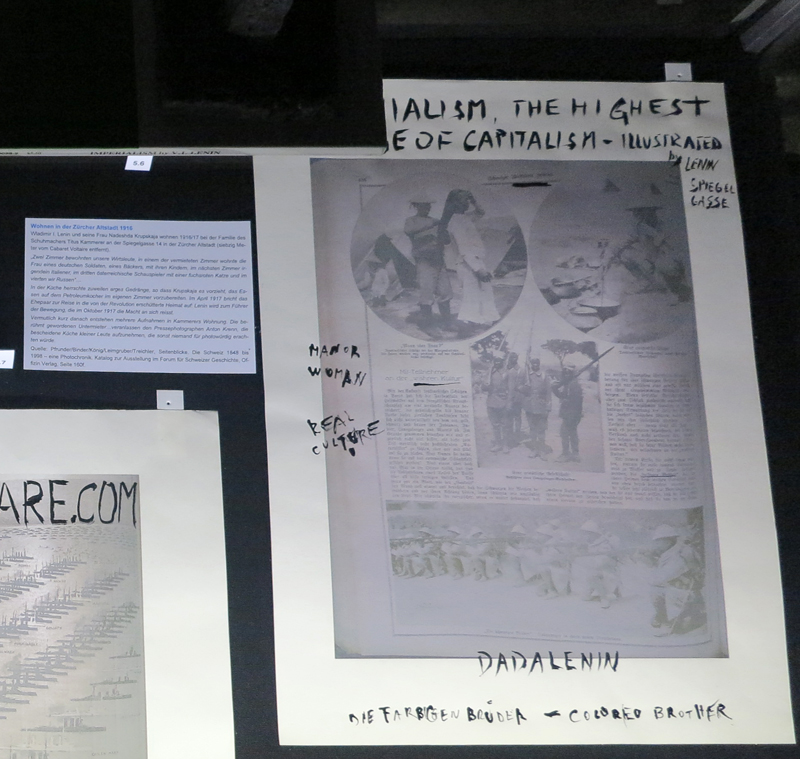
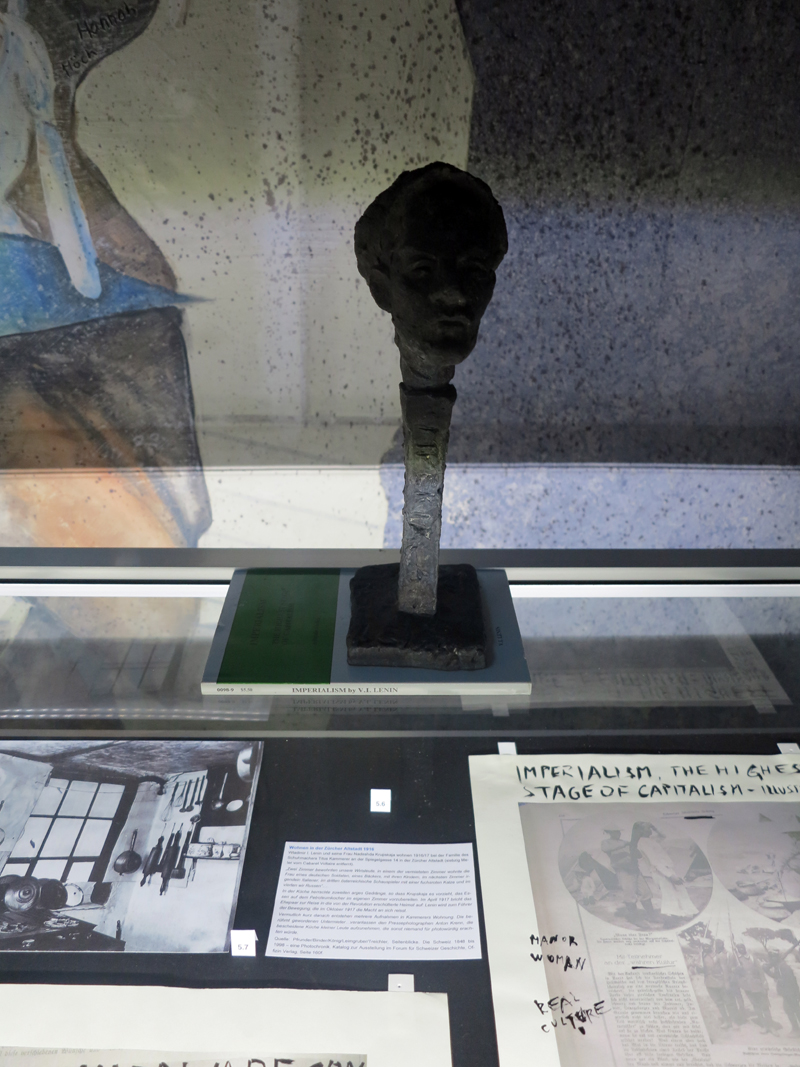
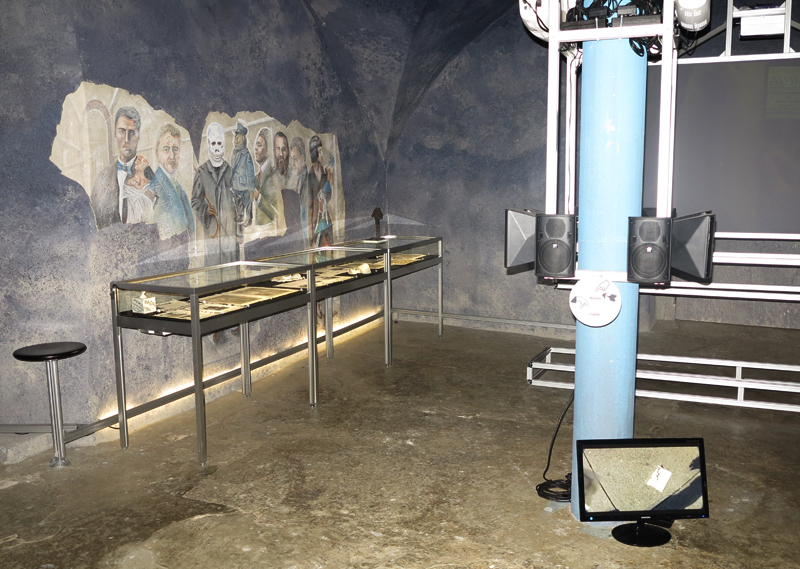
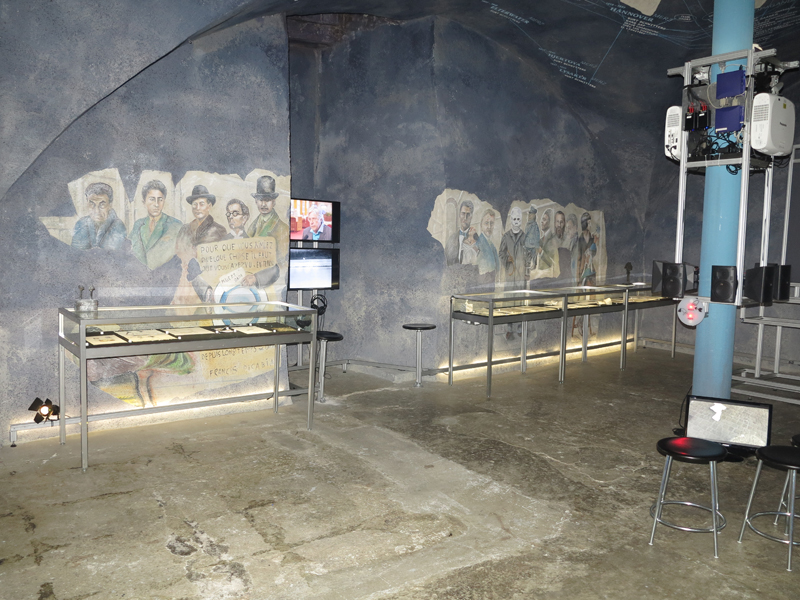
Lenin in Zurich (Imperialism the highest stage of capitalism - video)
A book by Lenin kicked from the LENIN HOUSE to the UBS HEADQUARTER... ..here as presented at the headquater of UBS bank in Zurich (before they very quckly removed me)
DADALENIN GAS WAR ANIMALS, 1914/18 / 2013
War is not only terrible for people but also for animals. They played important roles. All kind of animals were used in war for whatever kind of purposes, though mostly for transportation, communication and warfare. When the trench wars of WWI became gas wars with the invention of Fritz Haber‘s products gasmasks became the face of war death even for animals. The gasmask was a reminder of the new omnipresent and invisible nature of lethal war threats. Animals were also used for suicide missions with explosives. In one of the images, a dog carried a suicide west – currently so prominent - running under a tank with a stick standing out serving as a trigger of the explosives. Dogs were trained to run under approaching tanks through appropriate feeding. Countries at war saw large popular drives for dogs, horses, mules and pigeons which in most cases where just left behind and abandoned after employment if they had survived machine guns, bombs, gas attacks, malnutrition, stress, winter temperatures and exhaustion.
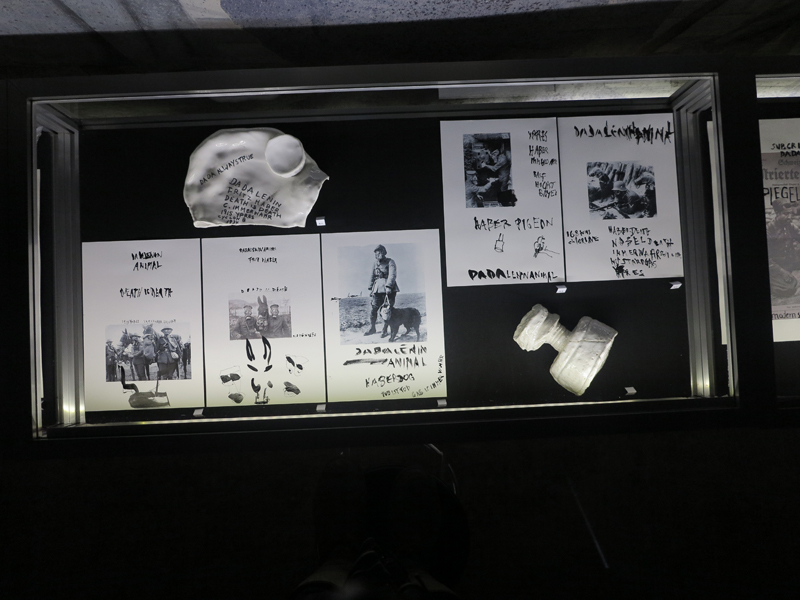
porcelaine
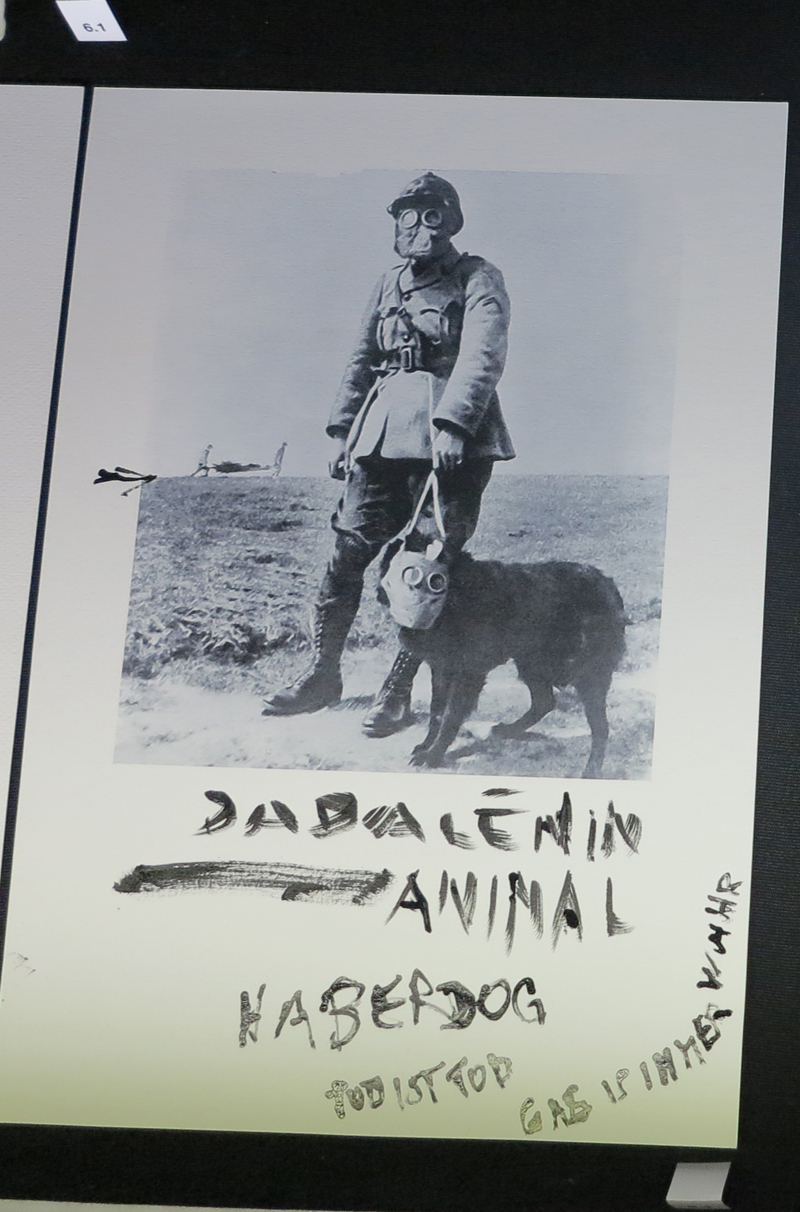
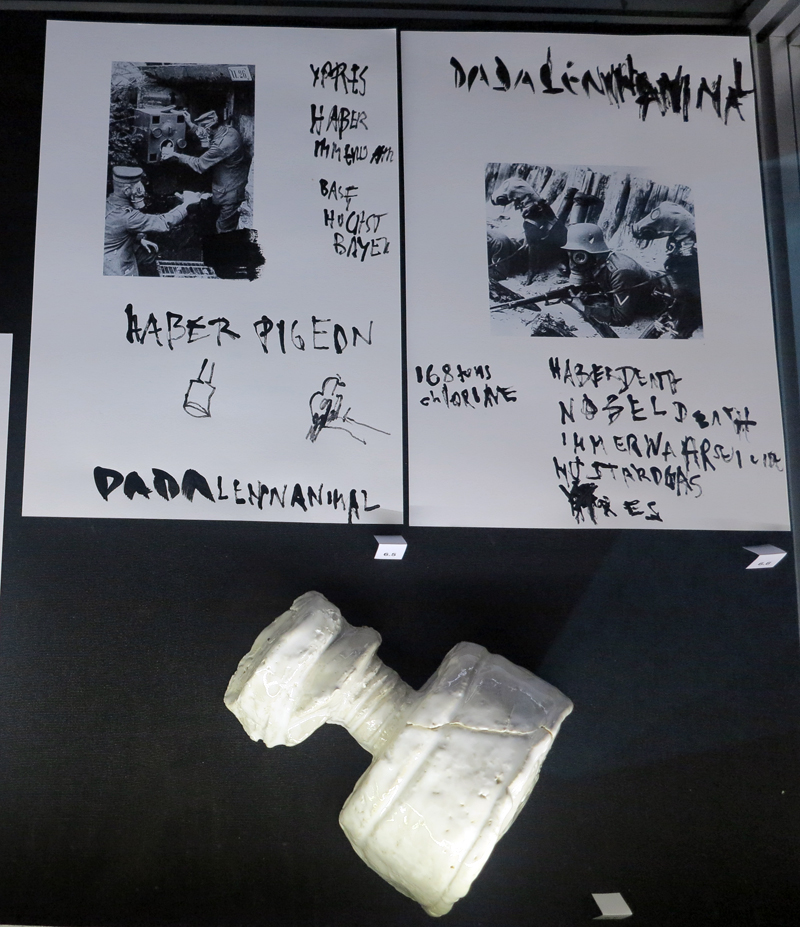
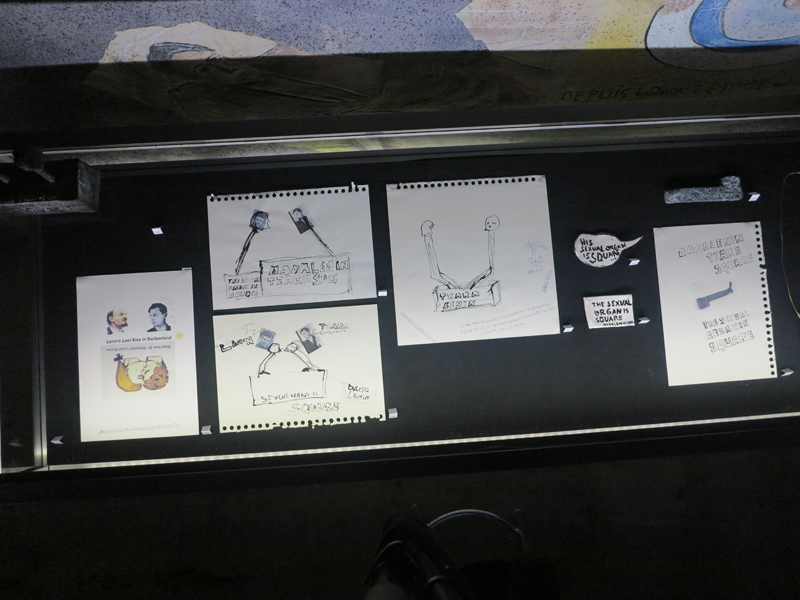
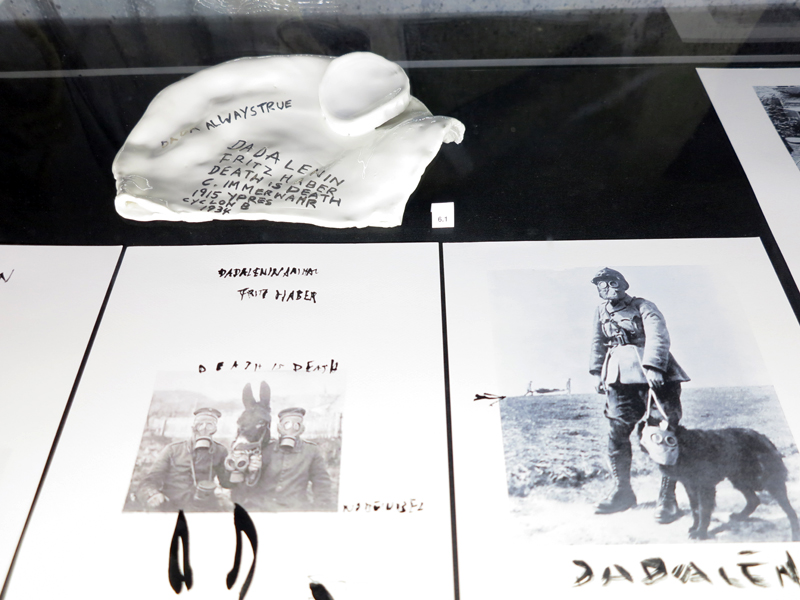
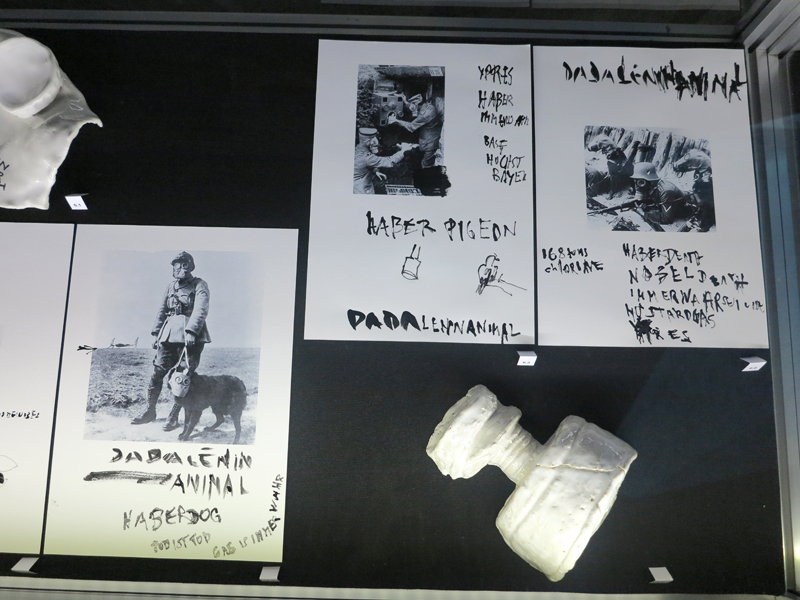
DADALENIN FRITZ HABER CLARA IMMERWAHR
Fritz Haber developed mustard gas and weaponized it during World War I. It‘s was first used in 1915 in Ypres. About 100 000 died due to his gas, half a million people were seriously insured and WWI got a new visual signifier: the gas mask. His wife Clara Immerwahr (her name translates “always true”), a chemist, protested Haber‘s work and committed suicide upon it’s first deployment. In 1918, Haber won a prix Nobel in chemistry and kept developing new gas products, including Zyklon A and B, used in Nazi gas chambers a decade and a half later. In spite of his national importance and celebrity, Haber, a German Jew, was kicked out of Berlin and his Kaiser Wilhelm Institute for Physical Chemistry and Electrochemistry of which he was the director by the Nazis in 1933 and committed suicide (as some records indicate) in Basel in 1934. Part of his family died by the very gas he helped to develop. Haber’s and Immerwahr’s son committed suicide after the war. Fritz Haber defended the use of poison gas with the sentence „Death is death“. The tragic irony of these biographies are truely DADALENIN - some tragic-ironic paradoxes squeezed by war, ideology, creativity and destruction.
Fritz Haber developed Mustard gas and weaponized it, hence was behind the gasmask look so symptomatic for WWI depictions. Marcel Janco was one of the original Zurich Dadaists working with masks. All the Russians included in this segment had their lives altered because of Lenin‘s ability to turn his radical thinking into reality on the ground.
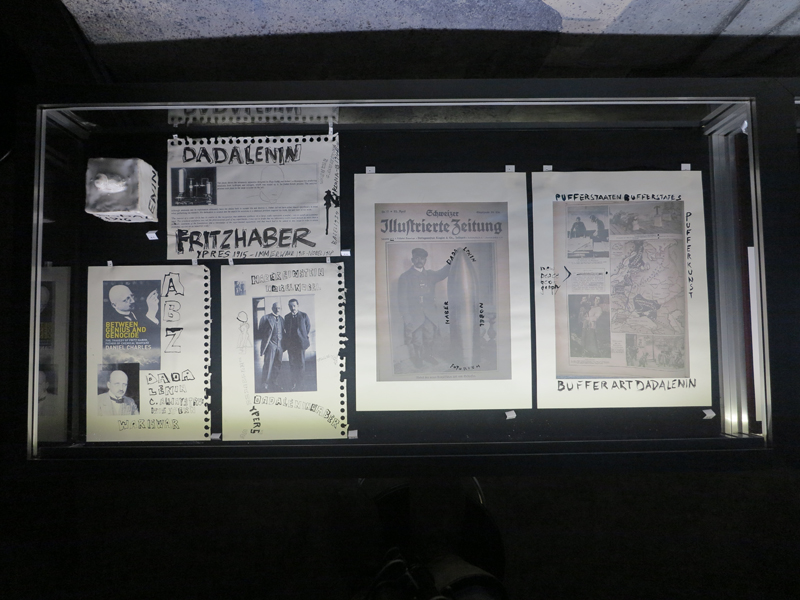
DADALENIN NEUE ZÜRICHER ZEITUNG, 2008
The New York Public library granted me direct access to the 1915, 1916 and 1917 editons of the Neue Züricher Zeitung and Schweizer Illustrierte Zeitung which reported constantly on WWI but also used some lines for a tiny announcement of the Cabaret Voltaire. The world of colonialism, war and technology, Lenin, the Russian Revolution as well as other revolts around the world got most of the exposure. I was fascinated by the early war photographs of the (gas) wars, the maps of the war and the various ads. Thus, I could see the geographic parallels of the war theater of 1914-1918 and those of the Iraq war that was still going on while doing the research. Some of the first area bombings from air crafts took place over what constitutes today Iraq then belonging to the Ottoman empire, „the sick man of Europe“ as it was called at the times. In Switzerland, all these papers are only made accessible through microfiche, whereas here in New York I was left alone with the originals I could photograph and handle myself. The photos I printed on various papers and paper sizes and intervened with my drawings and papers.
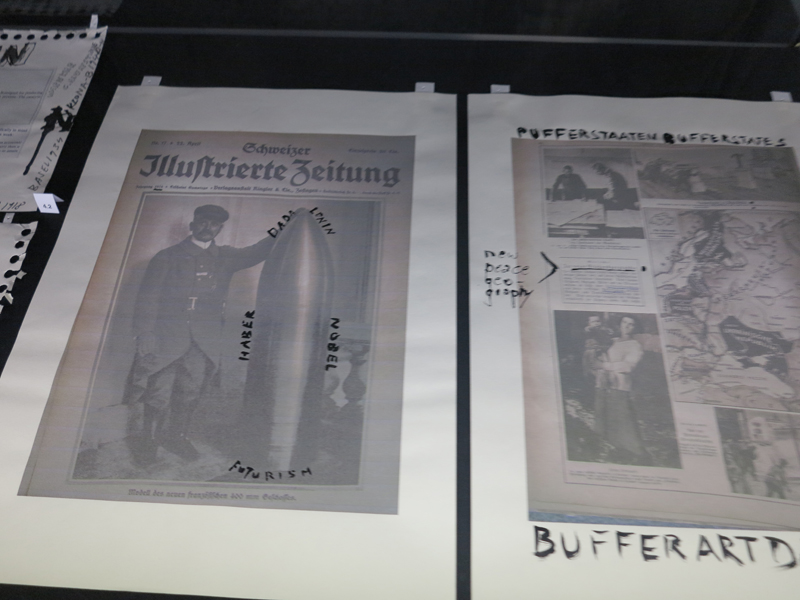
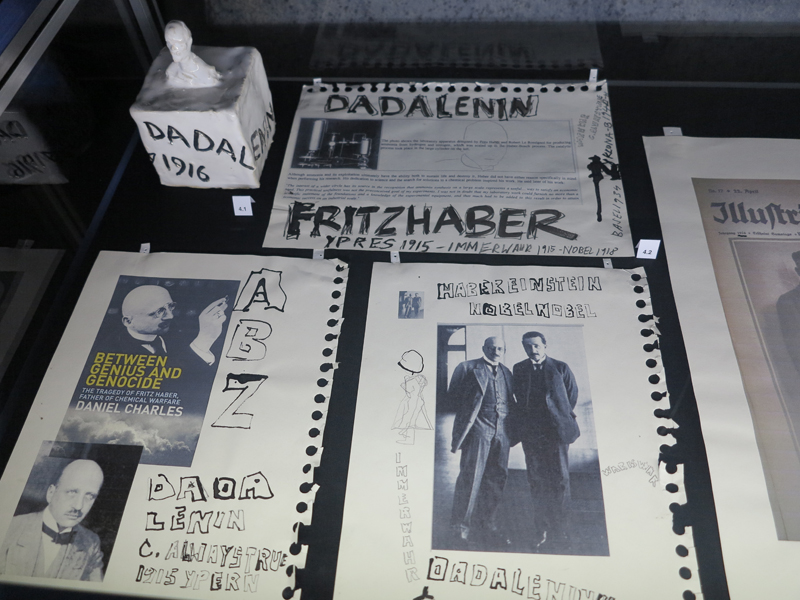
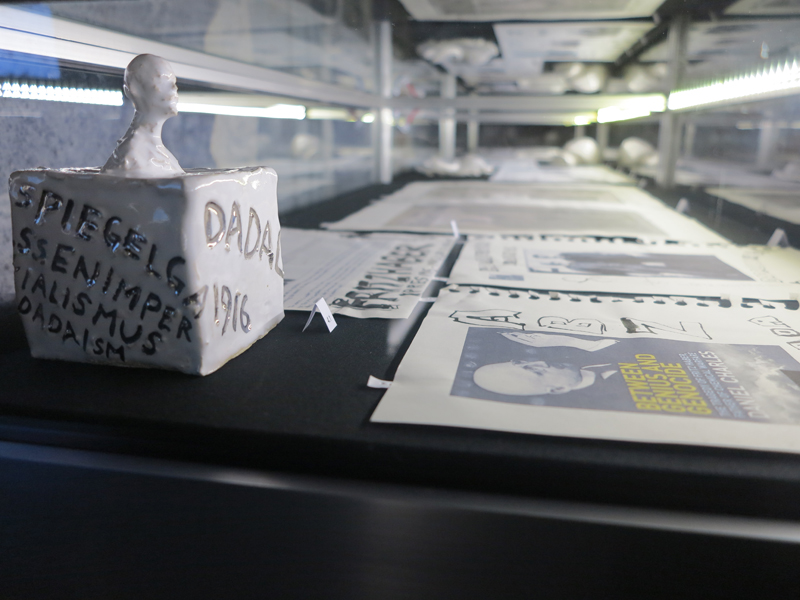
DADALENIN TZARA LENIN LOVE
Lenin and Tzara had a strange relationship that is far from understood. In Tzara‘s text „L‘homme approximative“ (1931) (The approximative man) he wrote about „having several voices in him“ ... „at night I was following those miserable figures of the night, really nameless emigrants.“ Tzara continued in a way that resembles a gay outing: „On a cord one man leads another man or they walk hand in hand an his side and yet, one is incorporating the other...“ (L‘homme mène en laisse un autre homme ou se promène à côté de lui, la main dans sa main et pourtant l‘un est enfermé dans l‘autre...“ (Tristan Tzara, Oeuvre complètes, vol. 3, p. 32)
Who knows what relationship Tzara really had with Lenin. But Salvador Dali, a good friend of Tzara played with ideas. In his famous painting Partial Hallucination, six images of Lenin on a piano, 1931, the artist depicted a man resembling Tzara with a set of cherries, Tzara‘s symbol as well as a symbol of love. On it, we see also his wonderful drawing/word game rhyming the French word end/fin, with love/l‘amour. By the way, the French term “end of love/fin de l’amour” sounds similar to “love making/faire l’amour.” The cherry symbol resembles gently a set of male testacies with a flash pointing towards the French word for „Love.“ On the piano, we see aunts eating up a score, also a quote of one of Tzara‘s oniric writings, and expressed in yet another of his text/drawings entitled „Le Coeur à gaz“ (The gas heart). A second reference to Lenin we find in Dali‘s painting The enigma of Wilhelm Tell, in which we see a strongman resembling Lenin with a super extended monstrous anormality of a tail /dick with feminine stockings on part of one leg as if cross dressing.

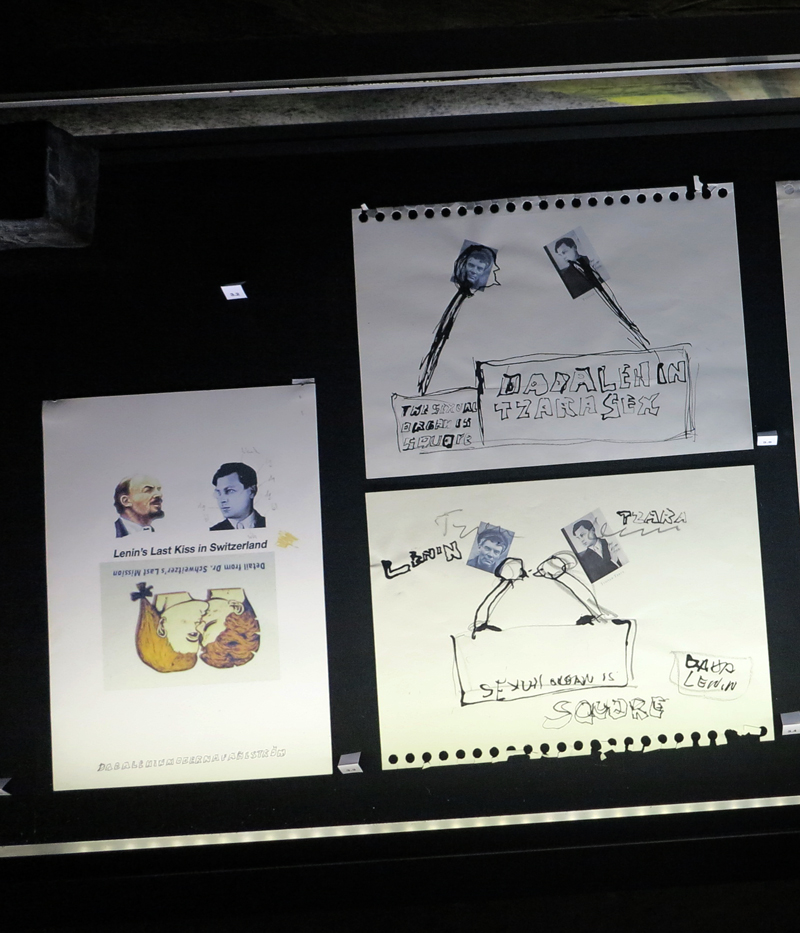

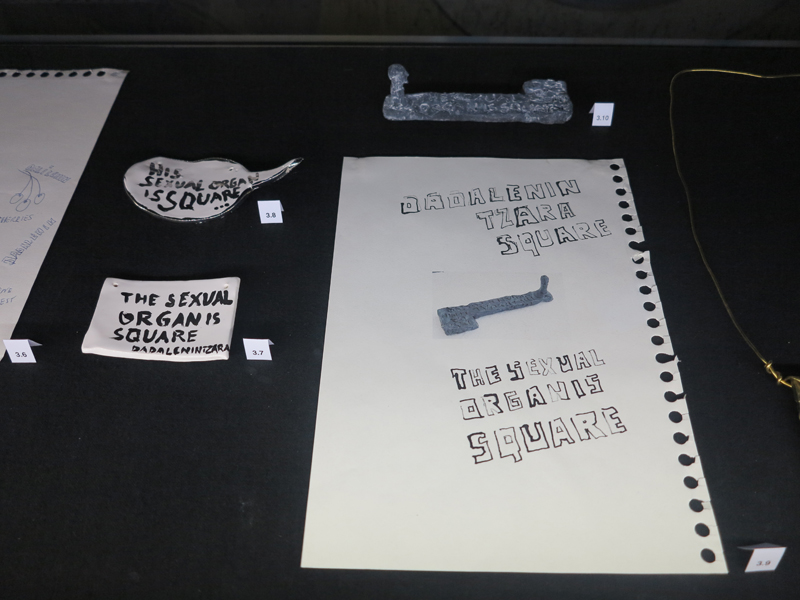


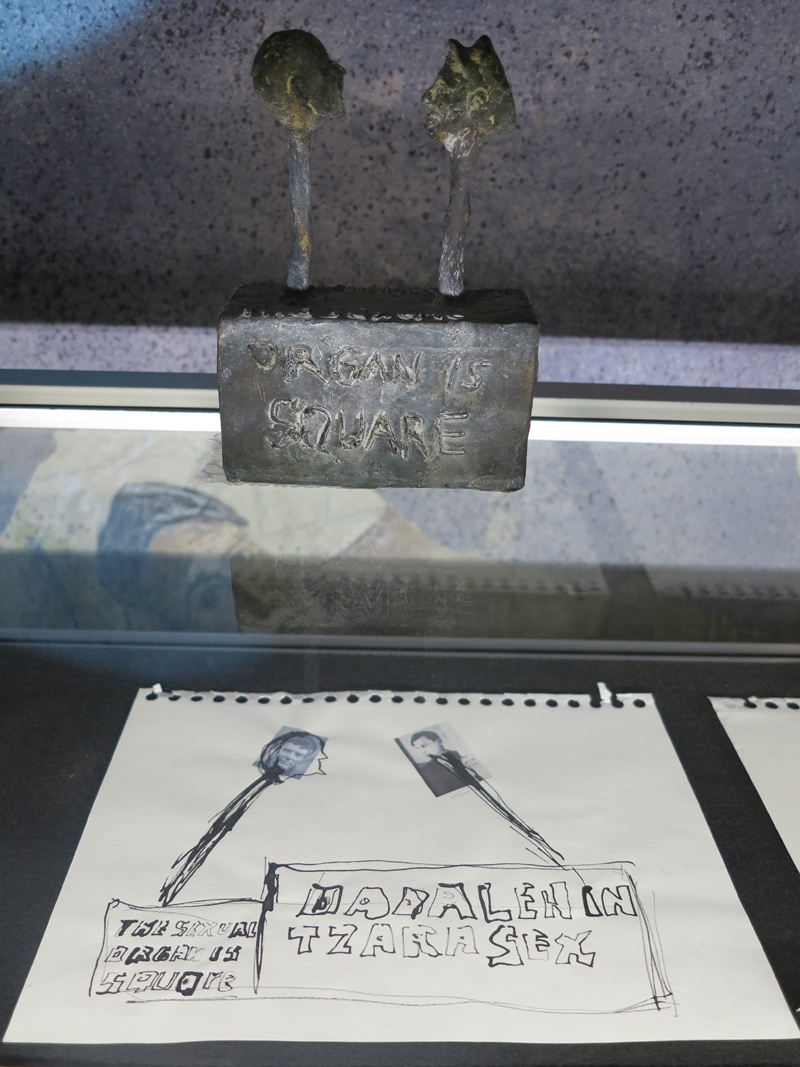
DADALENIN, The Sexual Organ is Square, 2008 brornze, 17.8 x 14 x 7 cm
installation view - right
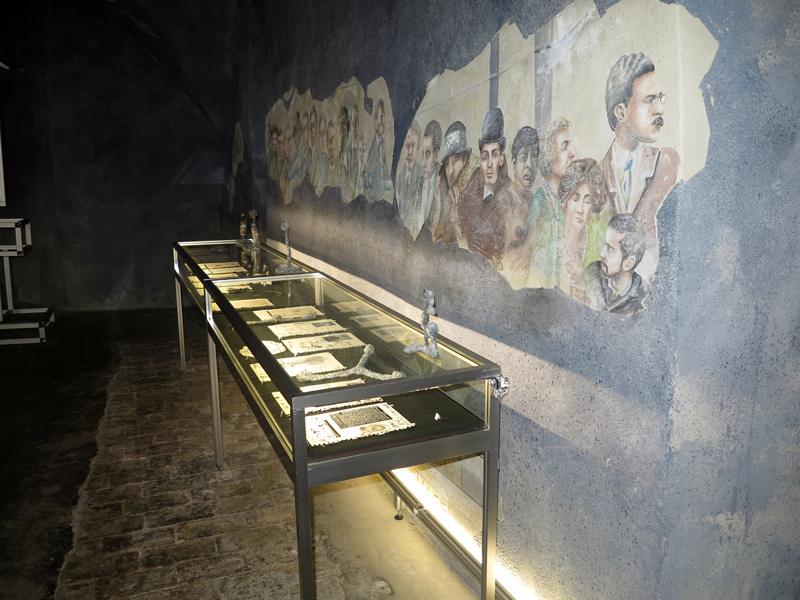
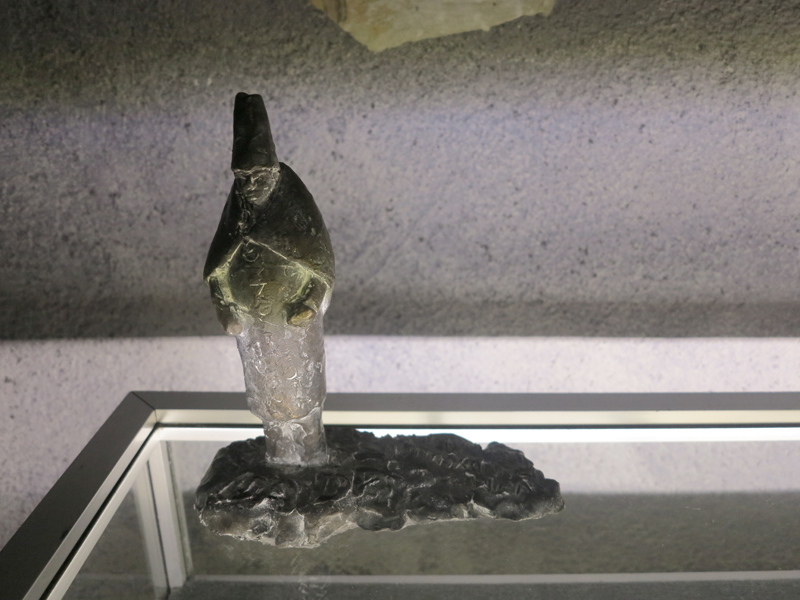
DADALENIN Hugo Ball, 2008 bronze 25 x 23 x 13 cm
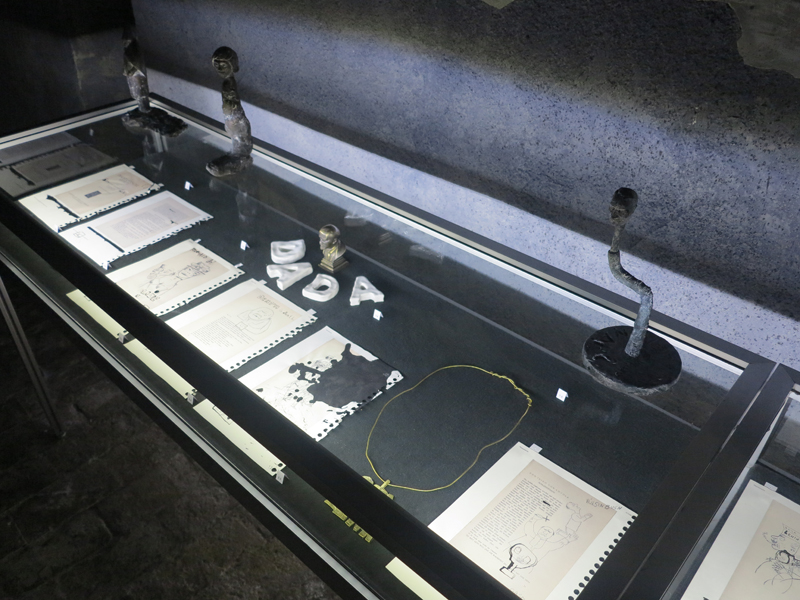

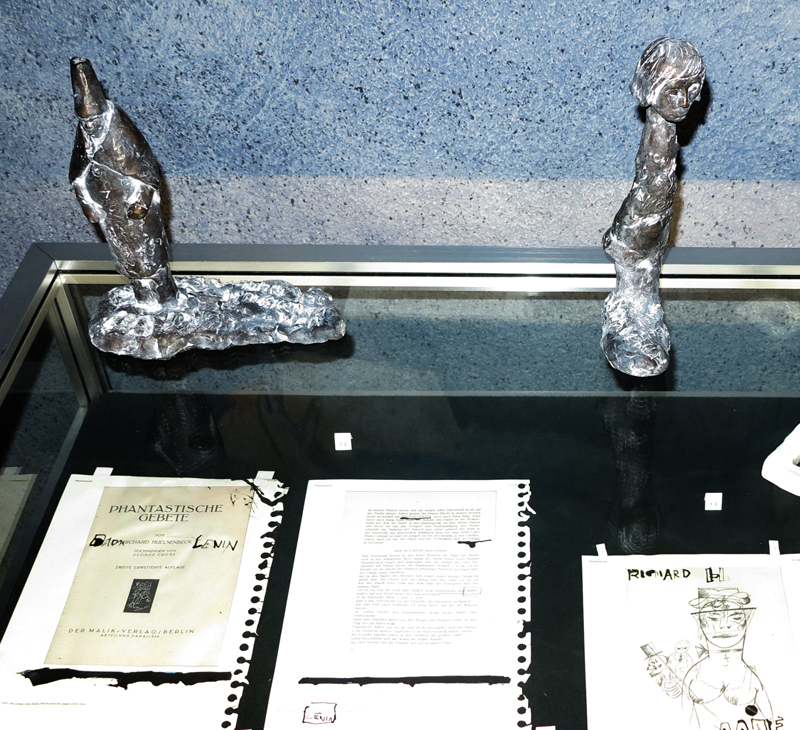
DADALENIN Hugo Ball, 2008 bronze 25 x 23 x 13 cm
DADALENIN Emmy Hennings, 2008 bronze, 27 x 12.5 x 6 cm


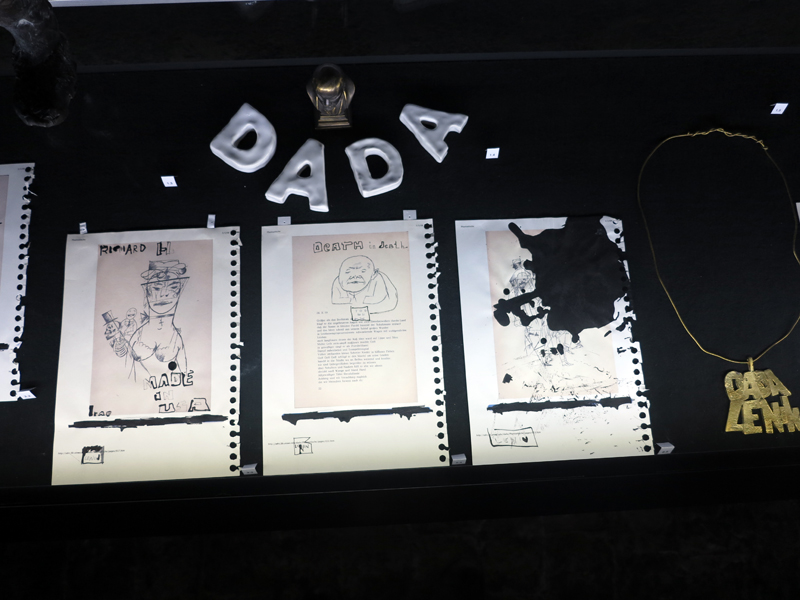
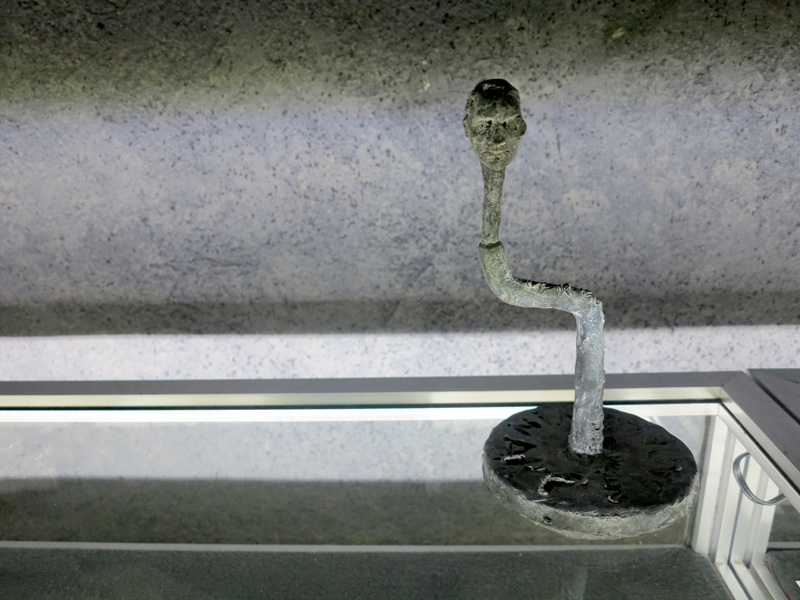
DADALENIN Jean Arp, 2008 bronze, 25.5 x 14 x 14 cm
DADALENIN DADALENINISTS
Not all my Dadaleninists are considered Dadaists and not all Dadaleninists I have cast in bronze. A bust of Lenin was made three times though two appear in combination with books and show him in Zürich as he appeared in a photograph in disguise. One such sculpture stands on an edition of his book Imperialism, the highest stage of capitalism which he wrote in Spiegelgasse, Zurich during WWI. The second bronze sculpture shows the disguised Lenin leaning on an edition of Lenin. Toward the seizure of power. I also made several DADALENIN sculptures that are combinations in bronze but which are here not included because they appear in either the Fritz Haber or the Tzara Lenin section of this publication. Lenin heads purchased on line or in the streets are also not included in this chapter of images. As mentioned earlier, I concentrated myself mostly on the Zurich members of Dada but ended up making works on only some of these protagonists. Alfred Jarry finds himself included because his drama „King Ubu“ was read by Hugo Ball at the Cabaret Voltaire in 1916 and embodies DADALENINIST thinking. Fritz Haber developed Mustard gas and weaponized it, hence was behind the gasmask look so symptomatic for WWI depictions. Marcel Janco was one of the original Zurich Dadaists working with masks. All the Russians included in this segment had their lives altered because of Lenin‘s ability to turn his radical thinking into reality on the ground.
DADALENIN DADALENIN
This selection of drawings and objects focus simply on the neologoism DADALENIN itself. It became for me some kind of working mantra around which this large and heterogeneous body of work onfolded in this publication started to form. “In the beginning was DADALENIN.” Reading Lenin, shopping Lenin busts on eBay, building sculptures in bronze, porcelain, glass and lead and destroying Lenin books as well as bicycling between Lenin monuments followed. The first Lenin readings took place in the summer of 2006 and evolved into an ongoing project of its own even though there were no commissions, no exhibitions, no plans. Towards the end of 2006 I moved into the world of materials with ink and pencil drawings, porcelain letterings and the purchase of eBay busts which I used initially in combination. Only after the first online acquisitions, did I become interested in the very act of eBay shopping and recognized ebay’s importance for memory work. The massive amount of industrially produced Lenin busts during the Soviet times inspired me to cast the letters DADALENN in bronze. Using porcelain and platinum painting was the result of antithetical thinking nd practice meditating Lenin‘s anti-bourgeois proletarian revolution.
DADALENIN RICHARD HULSENBECK
Richard Huelsenbeck was a founding member of Dada Zürich where he wrote his Phantastic Prayers in 1916, illustrated by George Grozs for a second edition published a few years later in Berlin. These Facsimile served as basis for my re-visitations with ink, ball pen and pencil playing with all kind of references, for example: HUELSENBUSH (G. W. Bush); Death is death (Haber) etc. In 1920 he published two works symptomatically entitled Dada siegt and Deutschland muß untergehen. (1920). His interest in Dada and his brilliant education and background did not prevent Huelsenbeck from joining the Nazi organization „Reichsverband deutscher Schriftsteller“ and from being a „Supporting Member of the SS“ contributing money. Due to the fact that his daughter in law was half Jewish, he emigrated with his family to the United States in 1936.
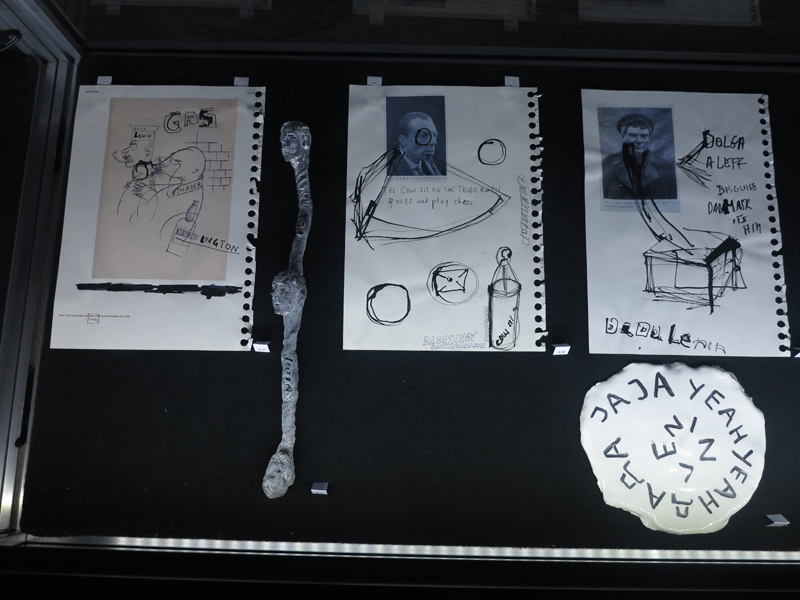
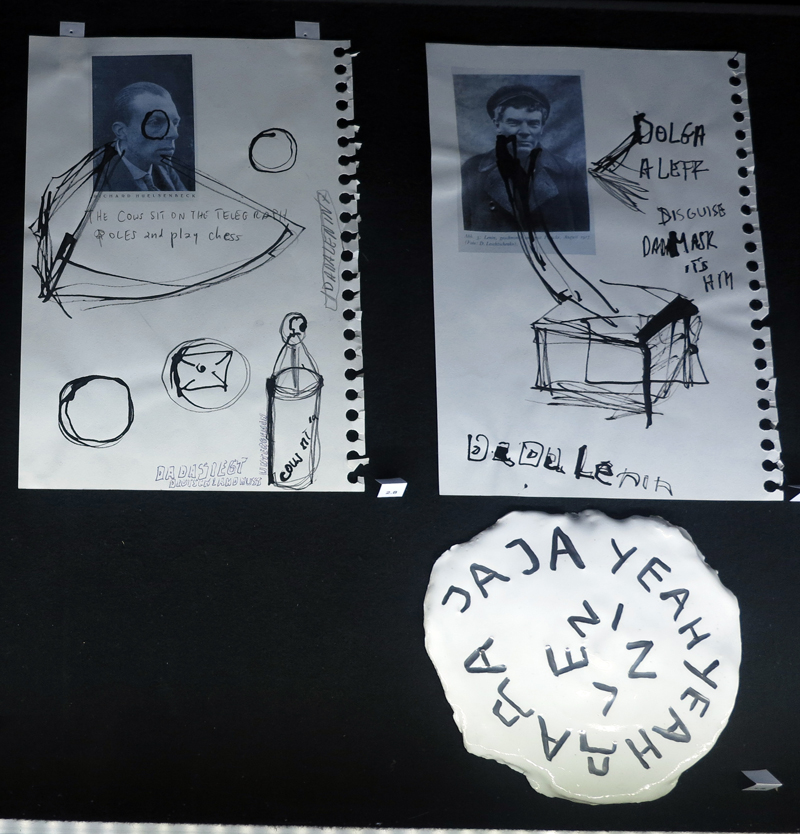
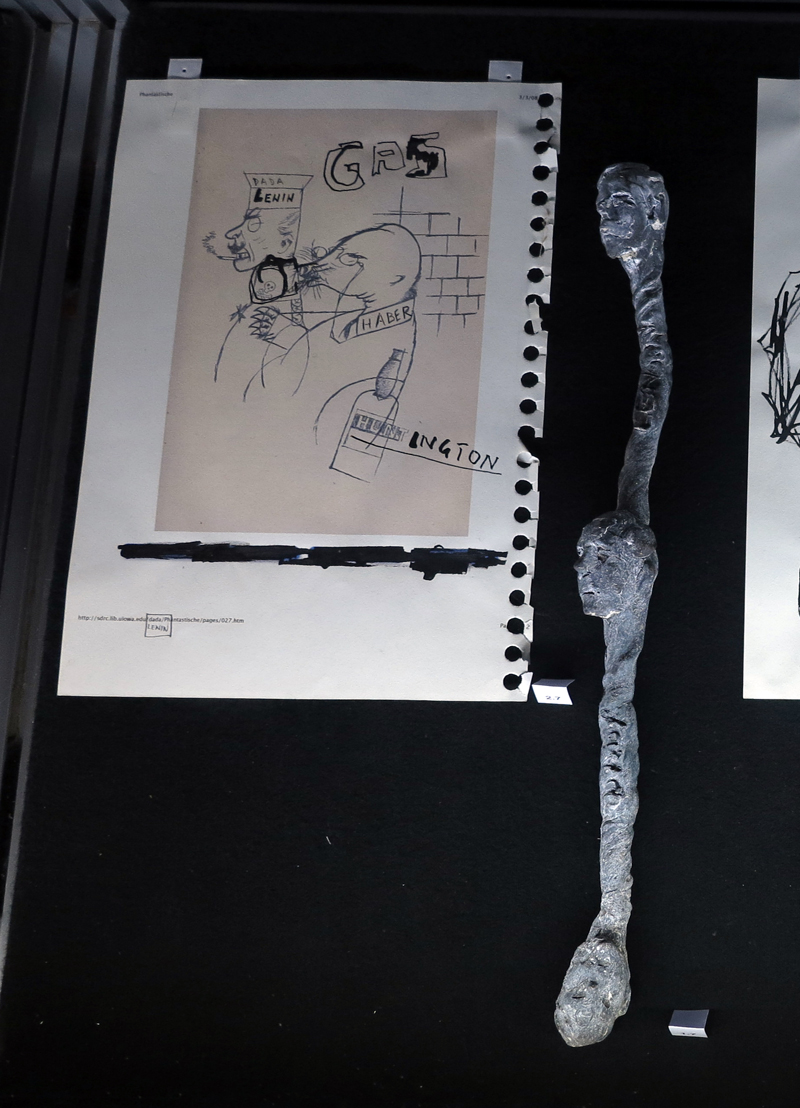
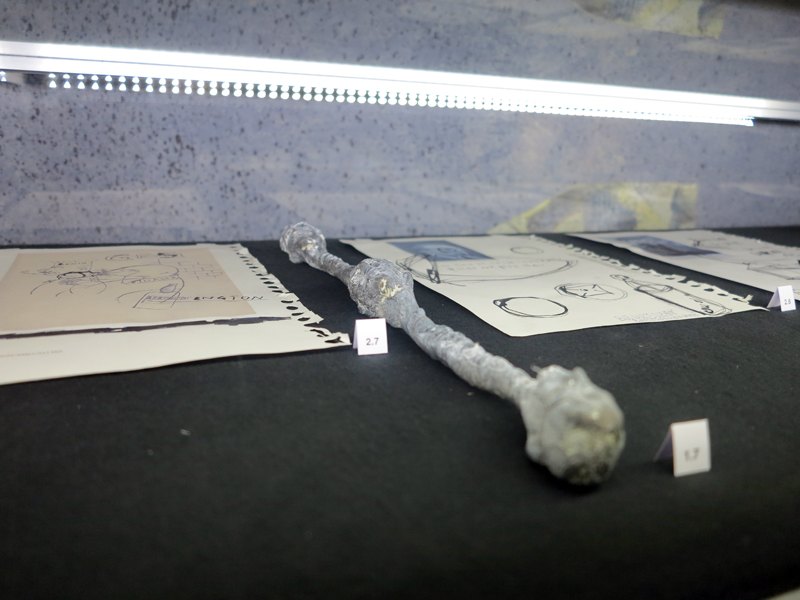

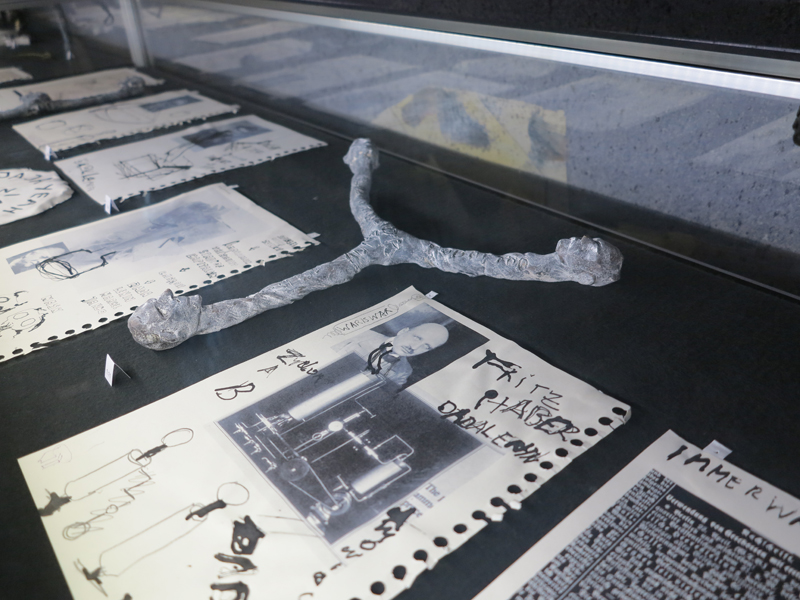
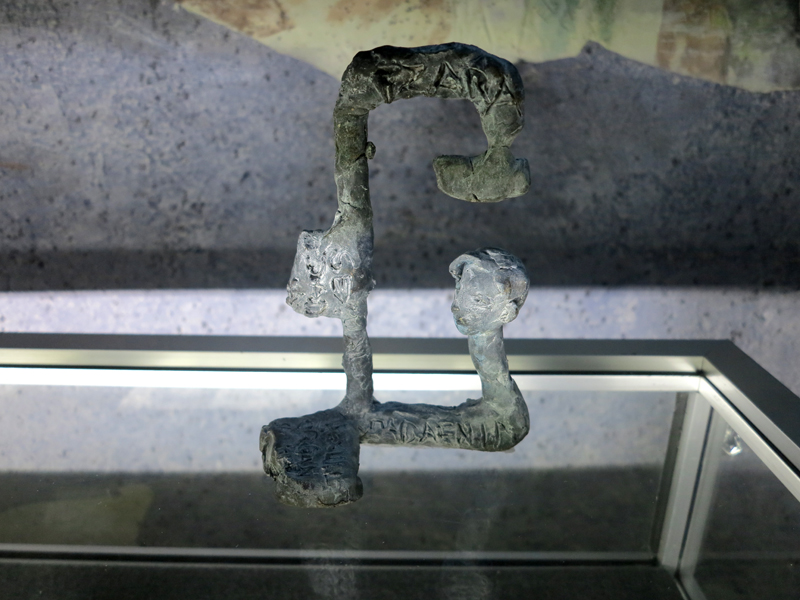
DADALENIN Tristan Tzara, 2010 bronze, 19.5 x 13.5 x 8 cm

in the shop
dadalenin special editon
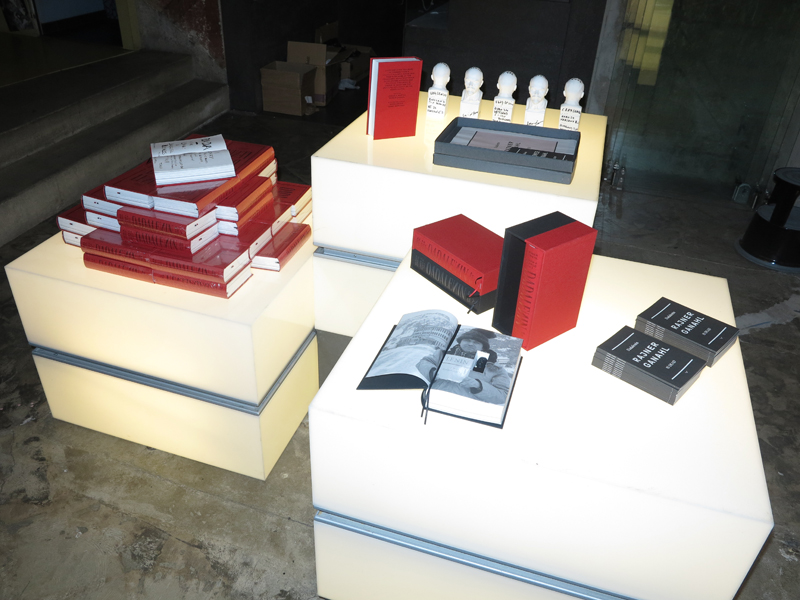
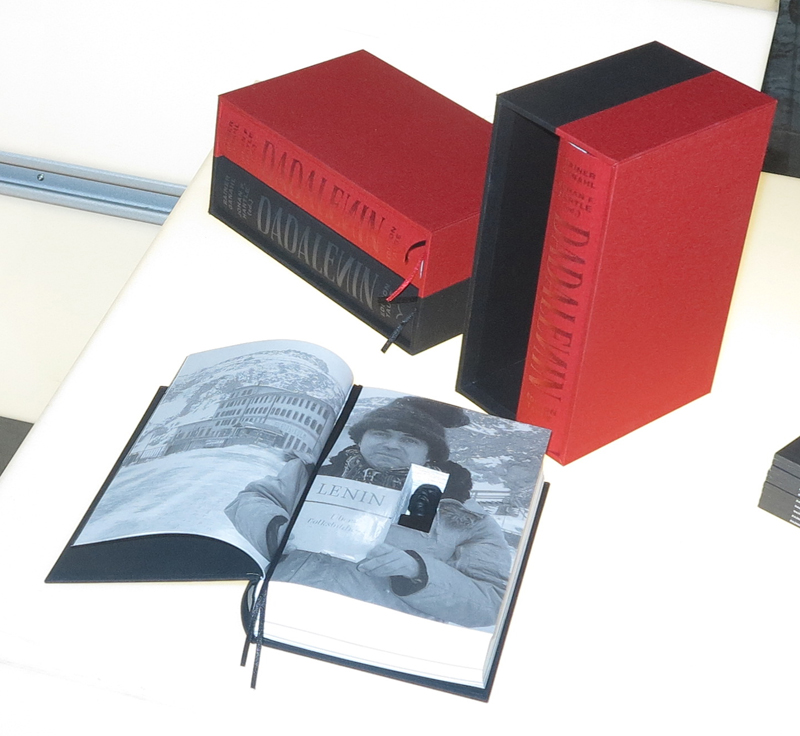
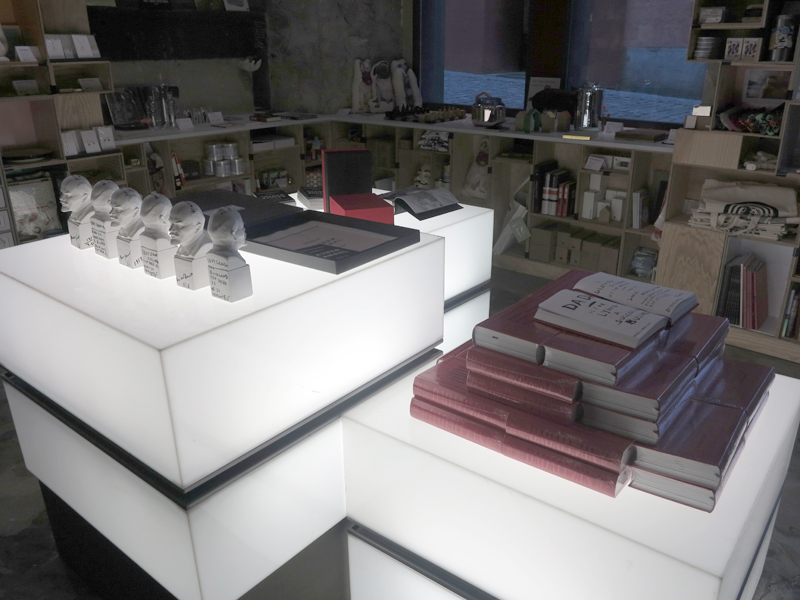
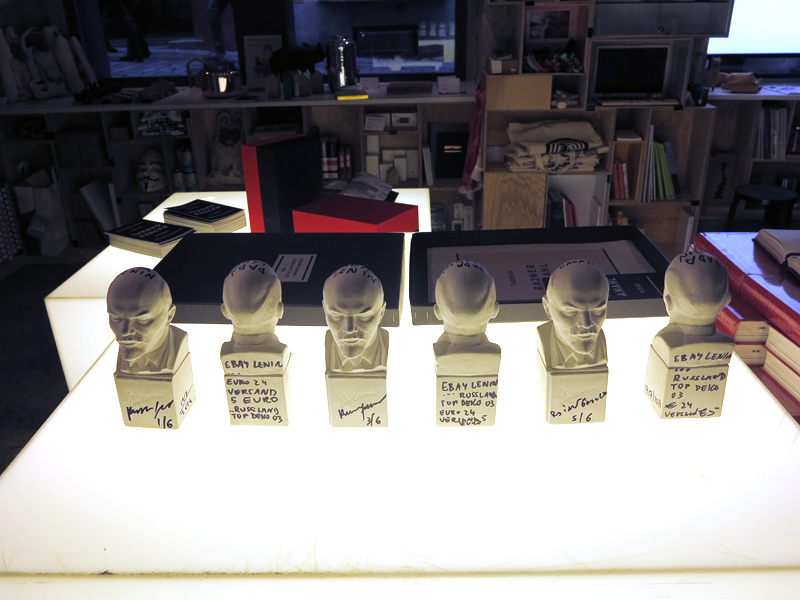
DADALENIN, EBAYLENIN, Gips Stuck Büste Wladimir Lenin Russland TOP Deko 03, 1917/2014
edition of 6 (plaster sculputure, work on paper)
